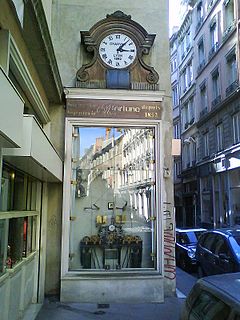
The 16th arrondissement of Paris is one of the 20 arrondissements of the capital city of France. In spoken French, this arrondissement is referred to as seizième.

Aubervilliers is a commune in the Seine-Saint-Denis department in the Île-de-France region in the north-eastern suburbs of Paris, France. The inhabitants of the commune are known as Albertivillariens or Albertivillariennes.

The Tour Saint-Jacques is a monument located in the 4th arrondissement of Paris, France, at the intersection of Rue de Rivoli with Rue Nicolas Flamel. This 52-metre (171 ft) Flamboyant Gothic tower is all that remains of the former 16th-century Church of Saint-Jacques-de-la-Boucherie, which was demolished in 1797, during the French Revolution, leaving only the tower.
Louis Féraud was a French fashion designer and artist.

The Avenue d'Iéna is a tree-lined avenue in the 16th arrondissement of Paris, running from the Trocadéro to the Place de l'Étoile. Passing through Place d'Iéna, Place de l'Amiral de Grasse, Place de l'Uruguay and Place Richard de Coudenhove Kalergi on the way. It is named from the neighbouring bridge across the Seine, the Pont d'Iéna. It has a length of 1,150 metres (0.71 mi) and an average width of 35 metres (115 ft).

Rue Pierre Charron is a street in the 8th arrondissement of Paris, near Avenue Montaigne high-fashion district.

The Wall of the Ferme générale was commissioned by Antoine Lavoisier and built between 1784 and 1791 by the Ferme générale, the corporation of tax farmers. It was one of the several city walls of Paris built between the early Middle Ages and the mid 19th century. It was 24 kilometers long and roughly followed the route now occupied by line 2 and line 6 of the Métro. It crossed the districts of the Place de l'Étoile, Batignolles, Pigalle, Belleville, Nation, the Place d'Italie, Denfert-Rochereau, Montparnasse and the Trocadéro.

Ambarès-et-Lagrave is a commune in the Gironde department in the Nouvelle-Aquitaine region of southwestern France.

Ernest-Paul Sanson was a French architect trained in the Beaux-Arts manner.

Francis Huster is a French stage, film and television actor, director and scriptwriter.

The Île des Cygnes or Île Maquerelle was an island on the river Seine in Paris. It was in the north-west part of the 7th arrondissement, between rue de l'Université and the Seine, the Invalides and the Champ de Mars. The Musée du quai Branly is located on it.

The rue La Boétie is a street in the 8th arrondissement of Paris, running from rue d'Astorg to avenue des Champs-Élysées. It is named in honour of Étienne de La Boétie (1530–1563), friend of moralist Michel de Montaigne.

The Rue de la Poulaillerie is a street located in the 2nd arrondissement of Lyon, France. It was first named rue Vaudran, and also rue Maudite in reference to Peter Waldo, who founded what was considered a heresy at the time, the street received its current name from the fact that people exchanged poultry until 1835, when part of this trade emigrated to the covered market of La Martinière.
The Rue Édouard-Herriot is one of the most important shopping streets of the Presqu'île in Lyon. It links the two most famous places of the city, the Place Bellecour (south) and the Place des Terreaux (north). Its northern part is located in the 1st arrondissement of Lyon, but the main part of the street is in the 2nd arrondissement. In its southern part, the street passes through the Place des Jacobins. It belongs to the zone classified as World Heritage Site by UNESCO.

Bernard-Gabriel Seurre or Seurre the Elder was a French sculptor. His younger brother Charles Émile Seurre (1798–1858) was also a sculptor.

Rue Bonaparte is a street in the 6th arrondissement of Paris. It spans the Quai Voltaire/Quai Malaquais to the Jardin du Luxembourg, crossing the Place Saint-Germain-des-Prés and the place Saint-Sulpice and has housed many of France's most famous names and institutions as well as other well-known figures from abroad. The street runs through the heart of the fashionable Left Bank and is characterised by a number of 'hôtels particuliers' and elegant apartment buildings as well as being bounded by the river at one end and the park at the other. With fifteen buildings or monuments classified as Monument Historique, it has more such listed sites than any other street in the 6th arrondissement.

Bernard Auguste Rives, known as Gustave Rives (1858–1926), was a French architect of the late 19th and early 20th centuries who designed residential, institutional, and commercial buildings in France in a style described as "opulent eclecticism." He organized many popular auto and aeronautical shows in Paris before the First World War.

Émile Picot was a French Romance philologist.

The Rue de l'Université is a street located in the 7th arrondissement of Paris, France.
Jules Antoine François Auguste Pellechet was a French architect, notable for his designs for buildings in France, Italy, and the United Kingdom and as an architect in the artillery technical section of France's Ministry of War.



















